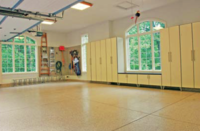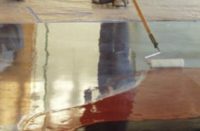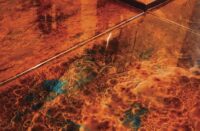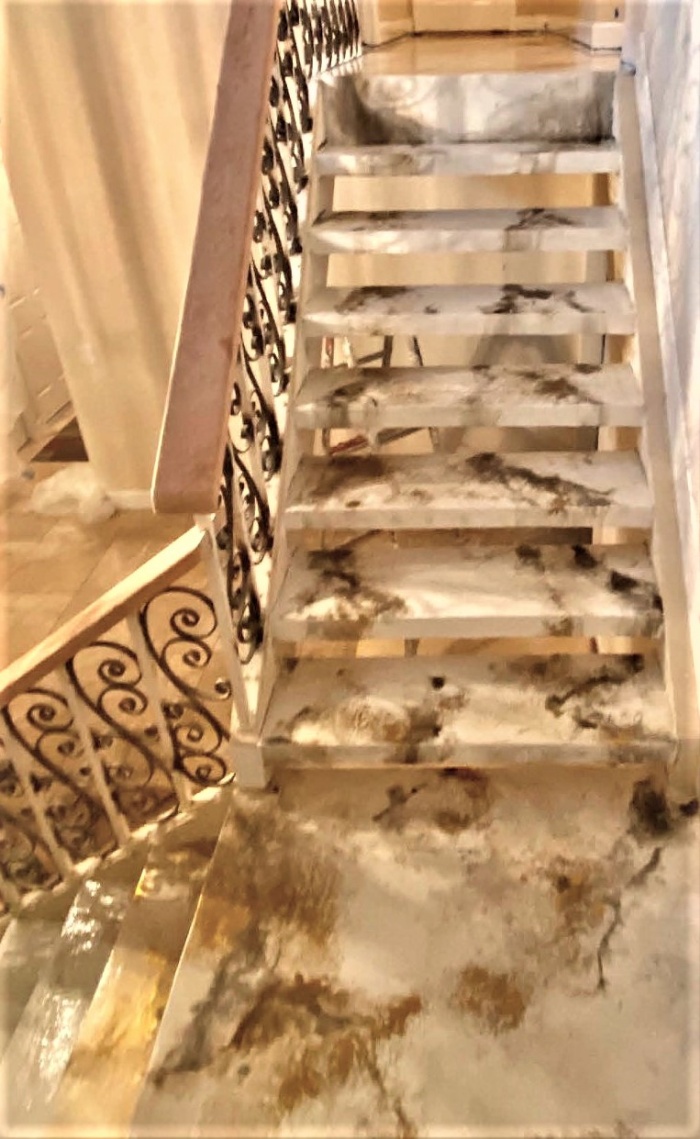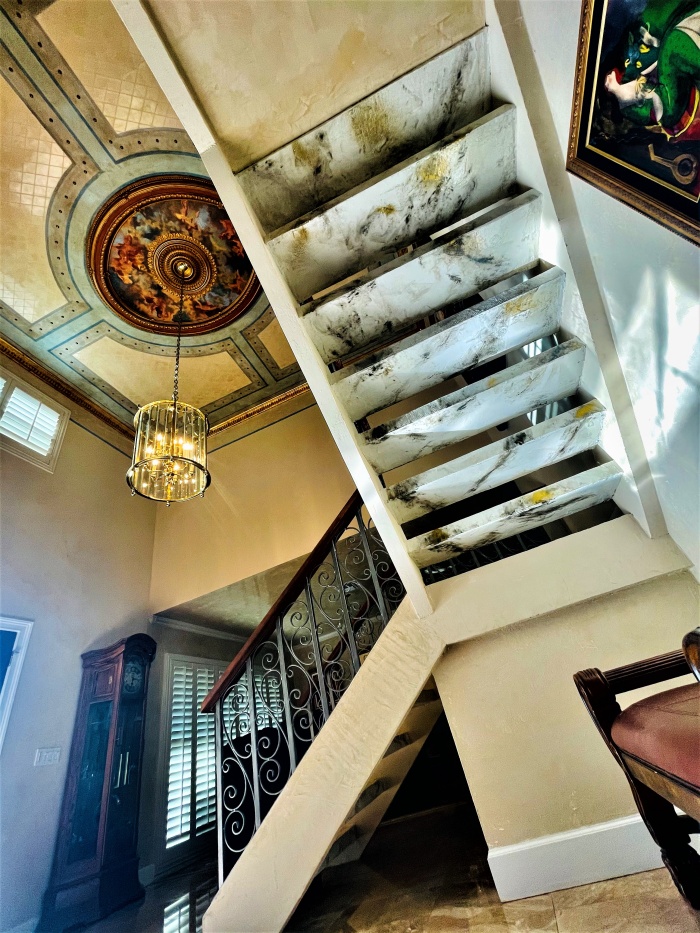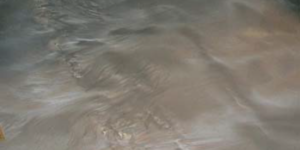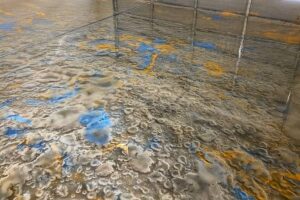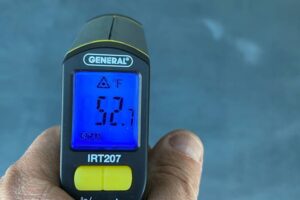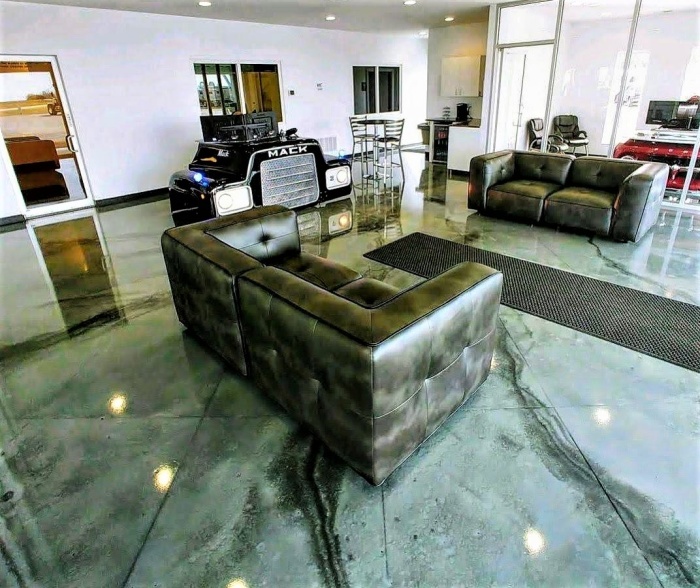
When asked what he likes most about McKinnon Materials’ Aurora metallics, the answer came quickly to Advanced Epoxy’s Ryan Stowell. “Its elegance,” says the Wichita, Kansas, company owner. “The final look is at the top of the line with any flooring choice.”
Stowell has used the metallic epoxy dust floor system and Aurora Metallic Epoxy Dust for roughly 10 years. That’s about as long as it’s been around. In his part of the country, he typically installs Aurora flooring in residential basements. Lately, though, he’s put it in what he calls “shop homes,” metal-clad buildings that house a residence on one side and a business on the other.
And, of course, he’s done his share of metallic garage floors in high-end homes, a popular trend nationwide.

Tools of the trade
To give Aurora Metallic Epoxy Dust floors movement, Stowell uses a squeegee. He says he used to use an 18-inch roller and back roll but he didn’t like the lint and other things getting into the floor. The squeegee, on the other hand, blends the colors together in a unique way.
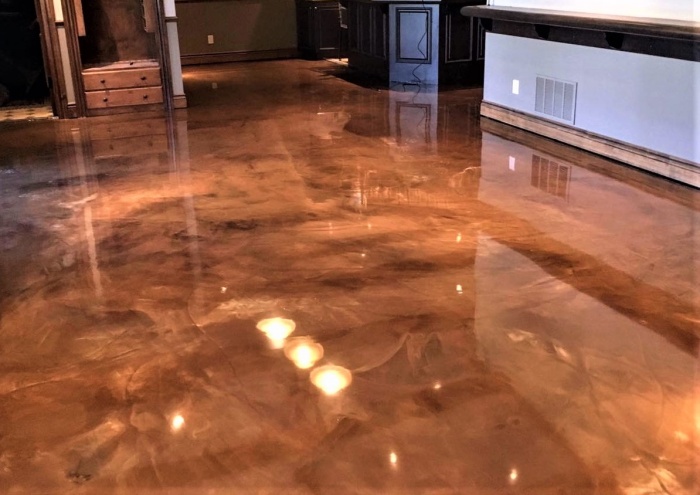
“One of the neater things about Aurora is that it’s powder-dust suspended in epoxy,” he says. “Unlike pigments that blend together and form different colors, metallics suspend without destroying their (individual) color.”
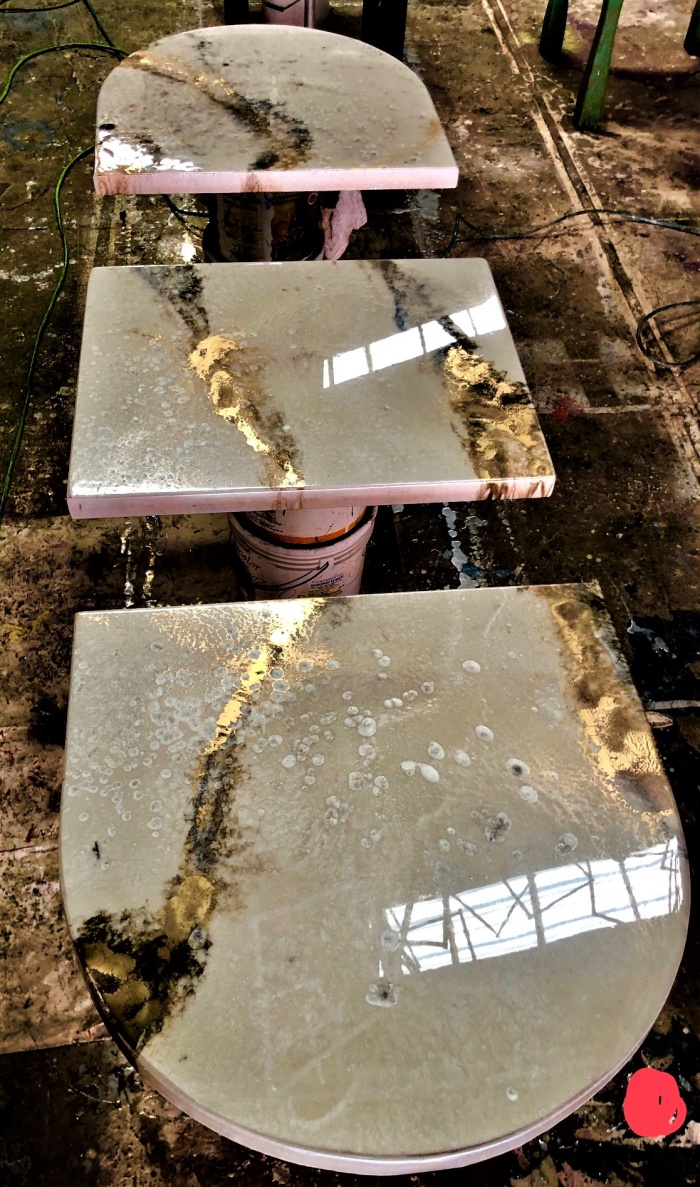
Stowell generally averages three colors per floor, with Bark Brown, Yellow Gold and Copper a popular combo in the Midwest.
For commercial jobs, he prefers to finish Auroa floors with a polyaspartic or a high-performance polyurethane. However, for residential jobs he likes to use a wax finish. “That way customers can maintain the floor themselves and wax it once a year.”
An artist’s take on Aurora
Artisan Ron Francis, owner of Ron Francis LLC in Tampa, isn’t in the flooring business. Instead, he’s into art. He uses Aurora to create everything from tabletops and counters to wall panels and staircases. He’s even used it make a 14-foot in diameter, seamless ceiling panel.
“It almost feels like I have unlimited choices when I use Aurora and epoxy,” he says. “If you know how to use metallics and epoxy, you can go in any direction.”
And he means that literally. Francis created an entire staircase clad with Aurora, including the undersides and risers of the individual steps. “It looks like marble,” he says. “I controlled the veining process by mixing different colors, putting them on stir sticks and swirling them around.”
It wasn’t an easy task, he admits, especially applying the Aurora mixture upside down without it running. “It’s taken me 20 years to learn these tricks,” he says, and the methods will remain proprietary.
Trade secrets revealed
But Francis will share this. Just like the famed Jackson Pollock, he uses a stir stick like a pencil. As the colors run, he moves the stick and lets the mixture fall. “It’s all about control and freedom,” he says. “The colors seem to float. You have a certain amount of time to move them around, break them up or intertwine them with something. It’s both fun and challenging.”
Besides sticks, Francis uses “a ton” of different spray paint and plenty of SeppLeaf gold powder to enhance his designs. He likes to put the gold powder in an air gun or in the palm of his hand and blow it onto his work. The artisan also uses very fine, ground glass.
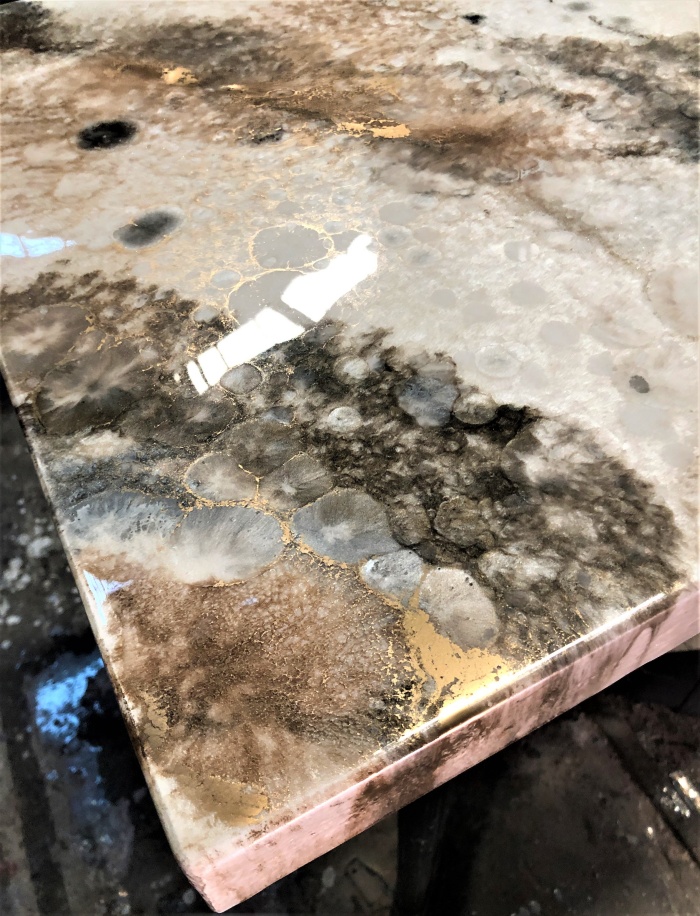
“The glass gives a piece sparkle without the color running,” he says. “Unlike cheap glitter that will run and bleed, the glass retains its vibrant color.”
Francis notes he thinks it’s incredible how artisans can manipulate metallics and epoxies with fire, air, denatured alcohol and “all kinds of stuff” — even water.
“Water creates a pit in epoxy,” he says. “You can flick water with your fingers to create a freckle on the surface. I found this out by accident when I was working and it was very hot. My sweat left divots in the epoxy.”
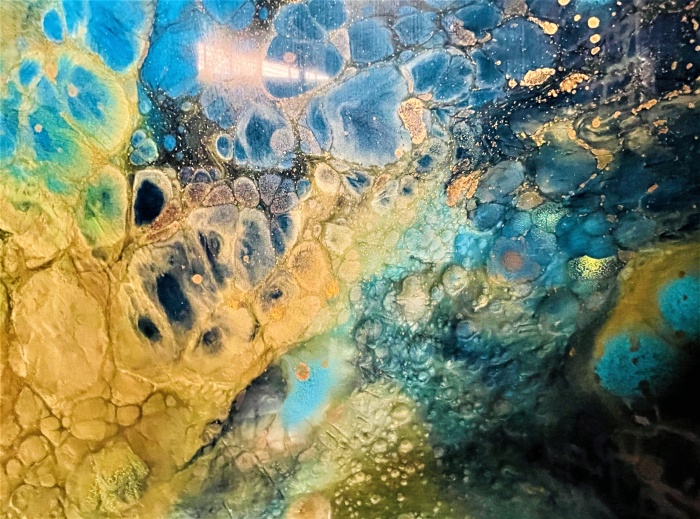
The allure of color
According to Glenn “Buster” Osteen, technical director for McKinnon Materials in Tampa, Florida, McKinnon introduced Aurora metallic epoxy dust about 10 years ago, although Australia had metallics on the market several years earlier. Over the years, the company has tweaked its formula to contain far less mica than it used to. It replaced some of it with pearlescence, the same thing auto manufacturers use in their color blends.
“The Federal Drug Administration approves the product we sell,” he says. “It’s the same colorant sold to cosmetic industries like Avon and Max Factor.”
Just like a white Lexus has an iridescent pinkish tint when you look at it from a certain angle, “The pearlescence creates an illusion that’s not really there. The material looks deeper,” Osteen says, and appears multicolored.
Today, the company regularly stocks 12 colors, with another 32 in its standard offering. They come in 4-ounce and 16-ounce containers. Custom colors are available on request.
Osteen discourages applicators from using multiple colors because McKinnon’s metallic products already combine colors for you. Each metallic presents in three different hues, light medium and dark. “This gives you a 3-D look as they each settle in multiple layers inside the epoxy,” Osteen says.
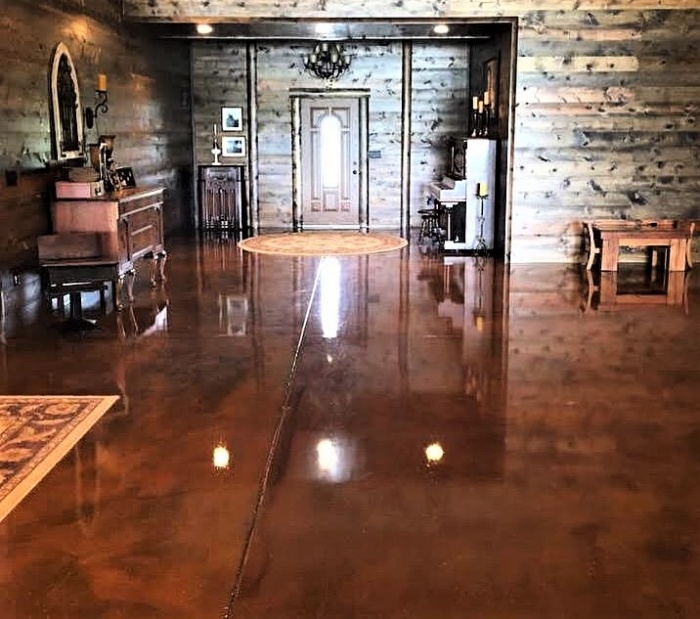
This blend of colored pigments has smaller particles than what McKinnon Materials has used in the past. They also vary in size. “When you mix them together, the epoxy starts on a journey,” Osteen explains.
“The reaction makes the epoxy thin itself out viscosity-wise. As the epoxy makes itself thinner, the pigments start to drop. With metallics, you can take advantage of that because you want the color to move around and settle at different depths.”
Special effects through and through
Because of this internal movement, Osteen discourages chemical disruptions such as spraying alcohol on the surface. “When you spray a solvent, it’s only going to react with the top couple of mils,” he says. “It will disrupt the surface and you’ll get some nice-looking effects. But only surface deep.”
Instead, he prefers blowing air on it to stir it up. Or using mechanical disruptions like pulling a trowel or gauge rake through the epoxy when it has thinned but hasn’t quite set. If you go the gauge route, he adds, it will put a cornrow looking design on the floor. This can be remedied by walking out with spike shoes and lightly backrolling the material.
“You don’t want to redistribute the material,” he says. “You just want to make the cornrows go away.”
As for manipulating the material, “If you disturb the epoxy in the beginning, (the pattern) will look plainer,” Osteen says. “Disturb it a second time — just before it starts to tighten up — the epoxy will hold the color more where you see it in suspension.”
He cautions installers not to use blue-steel, V-notched spreaders when putting down a primer. “You’ll get kinky little hairs floating in the material,” Osteen says. “It will scratch the primer and then pieces will float in the epoxy and in your job.” Instead, he advises, use a silicone-blade squeegee with u-cuts to better spread materials.
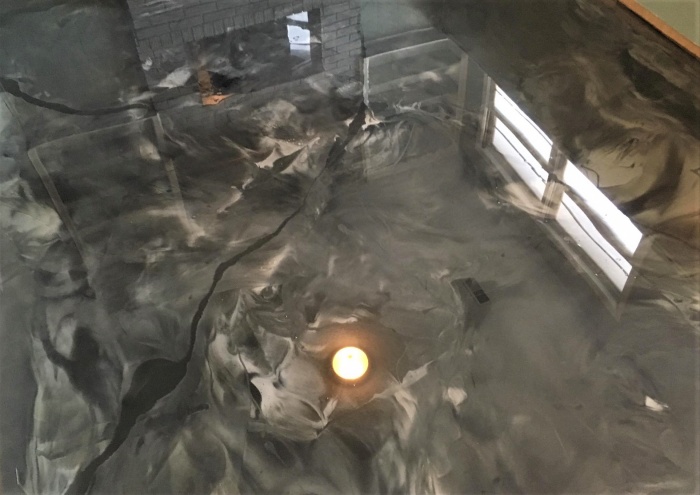
Keeping it simple pays off
Osteen, who’s been in the decorative flooring business for 38 years, believes a gauge spreader makes the job easier. “It makes sure you leave enough product on the floor,” he says.
He advises priming the floor first to stop the air from releasing into the epoxy and creating little “volcano-like disturbances.” Next, he says, combine a 4-gallon kit of epoxy with 16 ounces of color. Dump that onto the floor and pull it out with a 20-mil gauge spreader. You can cover between 60-63 feet per gallon if you pull twice in the same area, he estimates. If you only pull once, the material will cover between 48-50 feet.
When McKinnon Materials holds its training classes, which it does twice a month, Osteen focuses on this method. “It’s the easiest and fastest way to turn out a floor with the least amount of error and then get paid,” Osteen sums up. “Not to mention, it’s one of the best and best-looking industrial floors you can put down.”
